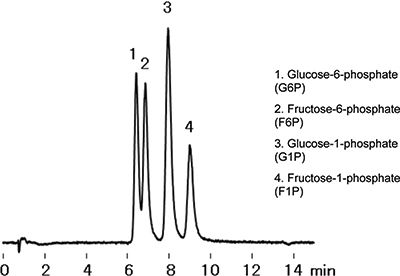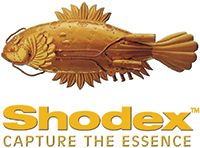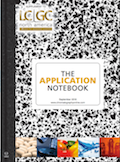HILIC Columns for Phosphorylated Sugar Analysis
The Application Notebook
Various types of phosphorylated saccharides are involved with glycolysis, glyconeogenesis, glycometabolism, and other naturally occurring biological phenomena. One example of a phosphorylated saccharide includes fructose-2,6-bisphosphate the most powerful activator of phosphofructokinase. Recent research has shown the phosphorylated saccharide intermediates created during glyconeogenesis and glycometabolism can be used in other ways than naturally intended for a number of applications, drastically broadening the interest in phosphorylated saccharide.
Phosphorylated saccharides occupy a central position in carbohydrate metabolism. Numerous sugar interconversions occur when the sugars are linked to phosphates and di-phosphates. When this occurs, the phosphorylated saccharides can function as glycosyl donors in many transglycosylation reactions, providing a variety of oligosaccharides, glycosides, and polysaccharides.
Phosphorylated sucrose and fructose have been synthesized by the transglycosylation process in plants, glycogen in animal tissues, and chitin. The isolated phosphorylated sucrose has further shown to potentially be effective in experimental drugs. The position of the phosphate group on the surcrose molecule directly affects how the new drugs interact within the body. Phosphorylated fructose has been recently suggested to be a part of the creation of ATP.
While phosphorylated mannose and glucose were found to be potent inhibitors of lysosomal hydrolase endocytosis by fibroblasts, as well as isolated from plants and bacteria, it was only just proposed that phosphorylated mannose is an essential component of the recognition marker on acid hydrolases from the direct evidence for phosphorylated mannose's ability on high uptake forms of lysosomal enzymes. With the knowledge of these few applications, the field has currently been exponentially growing.
Four variations of phosphorylate saccharides were analyzed by a Shodex HILICpak VT-50 2D column under LC–MS conditions. The sample contained two phosphorylated glucose and two phosphorylated fructose, each phosphorylated at a different carbon, providing different biological functions. This analytical condition can also be used with other detectors including RI, ELSD, and corona CAD.
Experimental Conditions
The analysis of glucose-6-phosphate, fructose-6-phosphate, glucose-1-phosphate, and fructose-1-phosphate was accomplished using the Shodex HILICpak VT-50 2D (2.0 mm ID × 150 mm ID, 5 µ) a HILIC column suitable for LC–MS. The column temperature was 60 °C and flow rate was 0.3 mL/min. The eluent conditions were 25 mM HCOONH4 aq./CH3CN=80/20. An injection volume of 5 µL of 1 µM of each sugar was used for the experiment. The HPLC system was coupled with an ESI-MS (SIM negative: m/z 259) detector.
Results
The aqueous sample containing the four phosphorylated sugars was analyzed successfully using HILIC and MS detection with Shodex HILICpak VT-50 2D (Figure 1). From this single run, each phosphorylated saccharide was prominently separated. The closest peaks were glucose-6-phosphate and fructose-6-phosphate, both eluting between 6–7 min.

Figure 1: The analysis of phosphorylated saccharides using Shodex VT-50 2D. Column: HILICpak VT-50 2D, column temperature: 60 °C, injection volume: 5 µL, eluent: 25 mM HCOONH4 aq./CH3CN: 80/20, flow rate: 0.3 mL/min. Detector: ESI-MS (SIM negative: m/z 259). Sample: 1-and 6- phosphorylated saccharides.
Conclusions
Shodex HILICpak VT-50 2D, a hydrophilic interaction chromatography (HILIC) column is suitable for anionic substance and phosphorylated saccharide analysis, LC–MS detection. The polymer-based packing material provides excellent chemical stability and minimum deterioration over extended periods of time.

Shodex™/Showa Denko America, Inc.
420 Lexington Avenue Suite 2335A, New York, NY 10170
tel. (212) 370-0033, x109, fax (212) 370-4566
Website: www.shodexhplc.com

Assessing Thorium-Peptide Interactions Using Hydrophilic Interaction Liquid Chromatography
February 4th 2025Paris-Saclay University scientists used hydrophilic interaction liquid chromatography (HILIC) coupled to electrospray ionization mass spectrometry (ESI-MS) and inductively coupled plasma mass spectrometry (ICP-MS) to assess thorium’s interaction with peptides.












